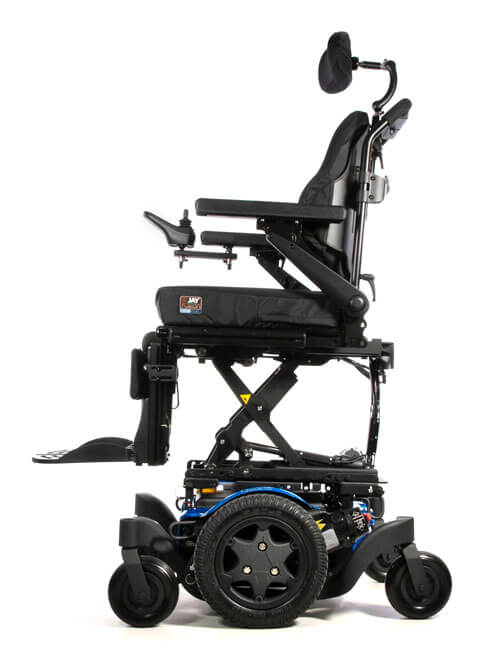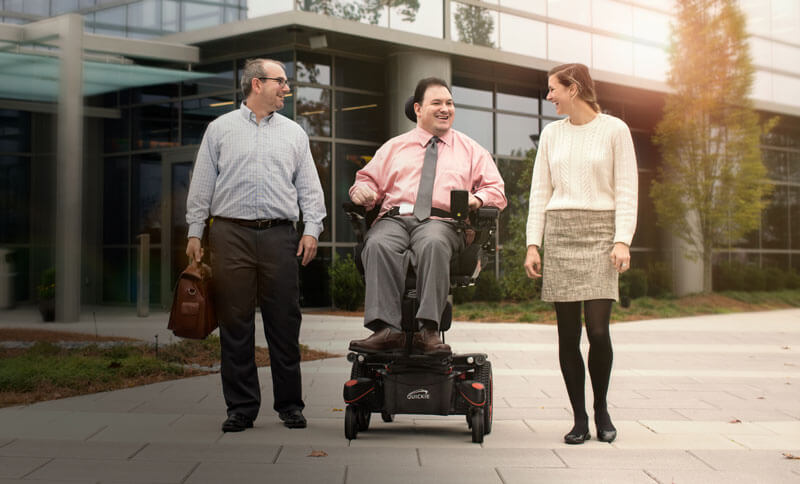As technology and design continues to develop, wheelchairs and power seat options have also evolved. And while it can be tempting to order a power wheelchair with every option available, it is important as a clinician to understand what the clinical benefits of each power seat function are in order to ensure appropriate scripting and justification – especially when funding is being sorted.
As an Occupational Therapist, I could write numerous papers outlining the clinical benefits of each power seat function available on power wheelchairs – but I want to dedicate this blog to one of the most important: the clinical benefits of power elevate.
First, let's quickly review what seat elevate is. In a power wheelchair, an actuator raises or lowers the entire seat frame while keeping the seat and back floor angles the same. It can be prescribed in addition to other power seat functions, including but not limited to: tilt, recline, and stand (if the chair has the capacity for the latter). This action can be activated through either the joystick or a memory seat function.

The seat elevate function can be a life-changer for many power wheelchair users, for two main reasons:
- Power seat elevate safely increases independence and function, potentially reducing caregiver hours and assistance level requirements.
- Little things, such as being able to reach for clothing or pantry items, can be achieved by wheelchair users around their home in an independent, safe, and functional manner. What's more, users can access items without over-reaching and can maintain an appropriate posture while doing so. This greatly improves safety in areas such as the kitchen, where different seat heights can be deployed to appropriately access the stove top, oven, or completing other kitchen tasks.
- Seat elevate can also increase independence, function, and safety of transfers with the option for height to be set for each individual transfer. If using a sliding board, wheelchair users can ensure they are always going against gravity and a standing pivot transfer can be set at just the right height to minimize assistance required.
- Power seat elevate significantly improves social interactions, enabling wheelchair users to engage with their friends and family at eye level.
- Power wheelchair users are able to have a conversation without looking up. In fact, they can raise themselves up and look down on someone if they need to.
- In addition, independence is also improved once again. By using the seat elevate function, power wheelchair users are able to order drinks at a café and speak to people over a counter.
- Seat elevate enables power wheelchair users to have an increased sense of empowerment, equity, confidence, and self-worth as they are able to independently interact within their environment and participate in a variety of social activities.
Until recently, seat elevate has had a significant downside. Users were restricted to a crawl speed while using the elevate function due to safety risks. This meant that users had to virtually come to a stop to enable seat elevate and were not able to drive at an efficient speed once in the elevated position. With enhanced technological innovations, power wheelchairs now come with the ability to move at the speed of an average walking pace while the seat is in the elevated position. Empowerment and participation in social and access goals have just hit another level!

Power wheelchair users can now enjoy a walk with their significant other and have a conversation while not looking up the entire time. They can participate in workplace meetings taking place over a lunchtime walk and interact at peer level. The ability for a person who uses a power wheelchair to engage in a conversation or activity at the same level as others can also have a positive impact on the wheelchair user's overall mental health in ways such as increasing confidence, improving self-image, decreasing anxiety, etc. This new fluidity of motion means no stopping and starting as someone goes from one task to the next. The wheelchair can remain in elevate and in a posturally supported position while the person goes from one task to the next.
When next scripting a power wheelchair with power seat options, I would recommend that you consider the clinical benefits of power seat elevate and the impacts it can have on your client physically, socially, and emotionally.
Resources
- Arva, J., Schmeler, M.R., Lange, M.L., Lipka, D., & Rosen, L.E. (2009). RESNA Position on the Application of Seat-Elevating Devices for Wheelchair Users, Assistive Technology, 21(2), 69-72.
- Schiappa, V., Piriano, J., Bernhardt, L., et al. (2019). RESNA Position on the Application of Seat Elevation Devices for Power Wheelchair Users Literature Update 2019.